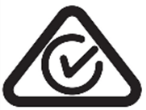Overview
This page answers frequently asked questions on electrical equipment safety and efficiency. If your query is not addressed below, please contact us using contact details on this page.
Through an online search:
- Supplier Registration – to verify the supplier is registered
- Equipment Registration – to verify the product is registered
- Equipment Certification – to verify that a product has nationally recognised certification.
By checking the equipment:
In-scope electrical equipment must have the Regulatory Compliance Mark (RCM) marked on the appliance – see below.

Regulatory compliance mark (RCM) Further information on approval marking is available on the Electrical Equipment Safety System (EESS) website
The most common and high-energy use products are subject to Minimum Energy Performance Standards (MEPS) and/or the Energy Rating Label. There is a fee to register the appliance, which varies according to the type of equipment and category of application. For more information, please see:
- The Greenhouse and Energy Minimum Standards (GEMS) Act 2012
- Equipment Minimum Energy Performance Standards (MEPS)
- GEMS Act Compliance
- Equipment Energy Labelling
The above information can be found at:
- Department of Industry, Science, Energy and Resources (Commonwealth)
- energyrating.gov.au
- energyrating@industry.gov.au
Caution should be taken when buying electrical equipment online. Some items for sale on the internet may not meet Australian safety standards. You should ensure that the supplier has an entity registered in Australia or New Zealand, and are contactable should you have any concerns regarding compliance.
Do not use ageing or faulty electrical appliances including an appliance with a frayed cord, cracked or broken plug.
If the supply cord is damaged for example frayed or cracked:
- dispose of the product or
- engage with the manufacturer, its service agent or a similarly qualified person to replace the cord to prevent a dangerous situation.
Do not attempt to repair faulty electrical appliances yourself – only qualified repair technician or a licensed electrician can repair appliances.
Electrical equipment with uninsulated plug pins indicates that they are over 10 years old. It is recommended that you check and dispose of any old electrical equipment showing signs of deterioration i.e. discoloration of the enclosure, cracks or deformation in the enclosure.
The state government is helping Victorian households reduce their power bills by offering financial incentives for free LED lights upgrades through the Victorian Energy Upgrades (VEU) program. If you are still using incandescent bulbs or compact flourescent lights (CFLs) in your home or business, you may get them replaced with LED lights under the scheme.
For more information, contact:
- Essential Services Commission
- VEU Support Service: (03) 9032 1310
The National Australian Built Environment Rating System (NABERS) is a national rating system that measures the environmental performance of Australian buildings. For more information, visit NABERS.
For household use
If the electrical equipment you intend on selling is designed or marked as suitable for household use, your equipment may fall under In-Scope electrical equipment. Suppliers selling in-scope electrical equipment must register as Responsible Suppliers.
To determine whether your electrical equipment is In-Scope, see section ‘In-scope’ on the EESS website. You may also wish to consider engaging a specialist consultant.
For exclusive for commercial or industrial use
All electrical equipment being sold must be electrically safe. This generally means you need to demonstrate your equipment meets the relevant Australian Standard. For information on electrical equipment that is not In-scope, see section ’Not In-scope’ in the EESS website for more detail
See the EESS site for information on the steps for compliance regarding selling electrical equipment.
An applicant guide has been developed to assist users with registering as a Responsible Supplier, and registering electrical equipment in the EESS Registration database.
Once registered, an email will be sent to the nominated email address with details of the Registered Responsible Supplier (RRS) number and a temporary password. Visit EESS for information on how to register.
General Enquiries and Database Technical Support: eessadmin@oir.qld.gov.au
Please state your issue in the email and include your contact number, if you require a call back.
A person may apply for Australian certification of electrical equipment to Energy Safe via EESS – see Equipment Certification Login. First time users will need to create an account in the certification database.
An Applicant Guide has been developed to assist users making an application for certification. There are two types of certificates:
Certificate of Conformity – for In-Scope electrical equipment risk Level 3. The Certificate of Conformity is also known as ‘Certificate of Approval’
Certificate of Suitability (voluntary) – for In-Scope electrical equipment Level 1, Level 2 or for not In-Scope electrical equipment.
Note: All certificates must be issued in accordance with the Equipment Safety Rules.
Related
See the list of Compliant RCBOs
Energy Safe has imposed additional requirements on the supply of RCBOs in Victoria. For further information see these pages:
Date: 29/12/2025 3:53
Controlled document
The currency and accuracy of this document cannot be guaranteed once printed or saved to a storage device. If in doubt, please check the ESV website for the current version.
Reviewed